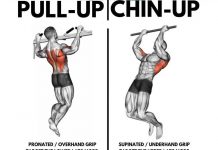How to Do Shrugs Exercise, a Technique for performing exercises with a barbell, dumbbells.
You may have huge arms, but if you have small traps you will look ridiculous, we suggest doing these shrugs exercise in order to pump your traps.
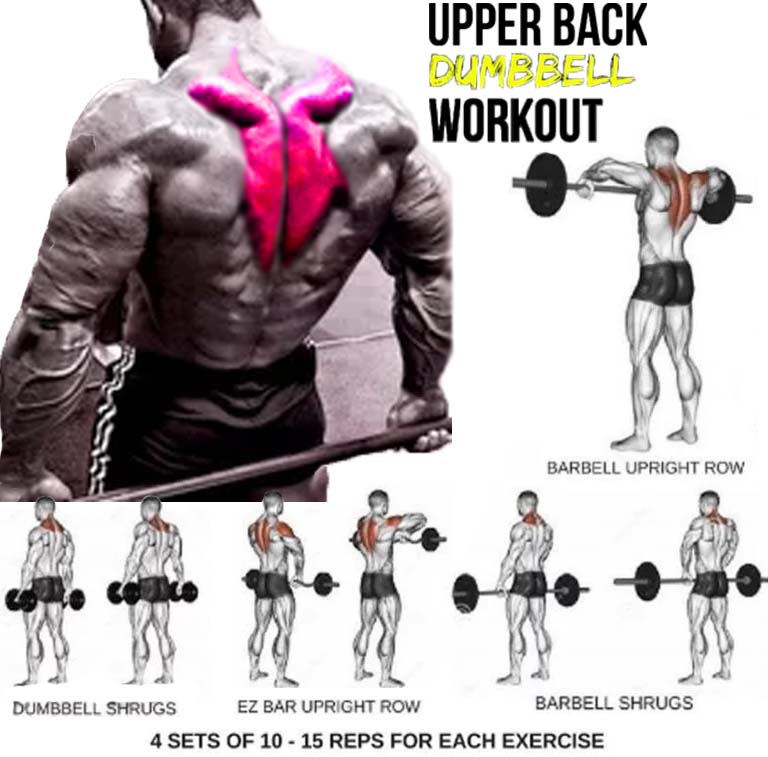
[wp_ad_camp_1]
Shrugs are an isolating exercise that grows the upper traps muscle, which is visually visible in professional bodybuilders. For beginners, this exercise is optional. Better to train the traps with basic exercises, which will tone the muscles, to begin with. Shrugs are performed in various versions, the technique of which requires correct execution.
|
The content |
What muscles work?
Exercise develops mostly the upper part of the traps muscle, with some variations it is possible to strengthen the middle and lower part. The rhomboid muscles, the lifting scapula muscles, also work. To support the spine and reduce the load on the lower back, it is required to independently tighten the abdominal muscles, maintaining the natural deflection of the spine.
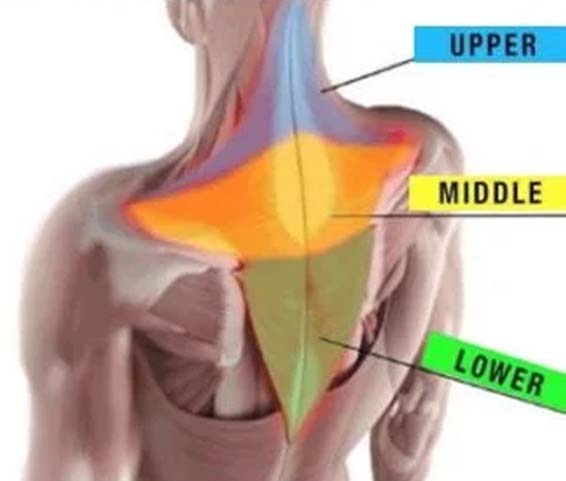
Pros Shrugs Exercise
With the correct technique of execution in conjunction with workouts for the back, shrugs exercises help not only to create a sports form of the shoulder girdle but also to improve posture in the cervical and thoracic regions.
They develop strength, which makes it easier to perform more complex basic techniques that involve the trapezius muscle.
[wp_ad_camp_2]
Minuses Shrugs Exercise
When using too much weight with incorrect technique, the exercise causes pain in the lower back as well as in the shoulder joints.
Rotational movements of the shoulders reduce the level of contraction of the trapezius muscle, thereby reducing the load on them.
The exercise is not suitable for those who have problems with the spine (displacement of the vertebrae, pinched nerves, hernias, protrusion of the intervertebral discs). These are the main contraindications for this exercise.
Excessive load on the trapezius causes the opposite effect of the exercise – posture curvature and hypertonicity of the trapezius muscle.
1. Barbell Shrugs: Execution Technique
Exercise allows you to lift heavy weights but should be increased gradually. Use a different grip technique, alternating the position of the hands (in pronation and supination) each approach – this will allow you to hold a large weight of the bar and evenly distribute the load on the trapezoid.
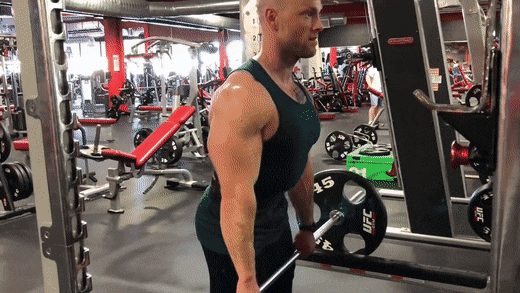
- When doing the front barbell technique, place the barbell on racks just below the pelvis.
Grab the barbell with an overhand grip, slightly wider than your shoulders. - Remove the barbell, move slightly away from the racks and place your feet shoulder-width apart.
- As you exhale, raise your shoulders, doing “shrugs”, at the peak feel the maximum contraction of the trapezoid.
- Hold for a second at the peak of the contraction. Perform the full range of motion.
- As you inhale, lower your shoulders, slowly stretching the traps.
[wp_ad_camp_3]
| Read more about Barbell Shrug
Important! Do not bend your elbows when lifting the barbell to eliminate additional bicep assistance. Move your shoulders strictly along the vertical axis, do not rotate your shoulders.
2. Behind the Back Barbell Shrug
In the exercise, the upper traps, the rhomboid, and the muscle that lifts the scapula receive the maximum load. This technique avoids the shoulders toppling forward by bringing the shoulder blades closer together.
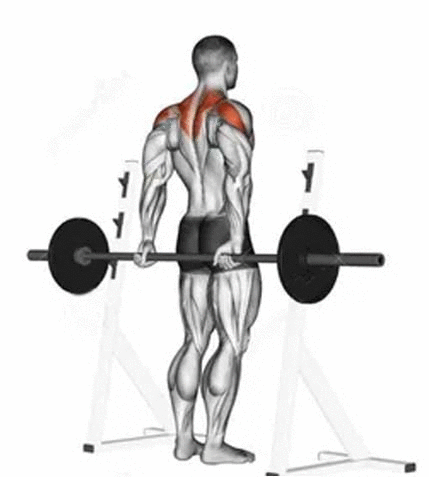
- Place the bar on racks at the level of the buttocks, turn your back to the bar.
- Grab a grip slightly wider than your shoulders from above, with the back of your hand forward.
- Gently remove the barbell by taking a step forward.
- Place your feet in the width of the pelvis, take your shoulders back. Don’t round your back.
- As you exhale, raise your shoulders to your head as much as possible, feeling a burning sensation in the traps.
- Lower your shoulders and stretch your traps muscles.
| Read more about Behind the Back Barbell Shrug
[wp_ad_camp_4]
Important! Choose the correct barbell weight, the burden should not outweigh and overwhelm the torso back, overloading the lower back.
3. Dumbbell Shrugs
Dumbbell shrugs can be performed while standing or sitting. The standing option is the safest since the shrugs in the sitting position due to the weight of the dumbbells put more stress on the lumbar spine.
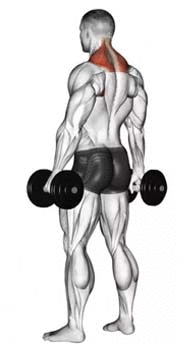
- Take dumbbells in both hands, take a stable posture, the feet should not be wider than the pelvis.
- Hold the dumbbells to the sides of your torso with your arms straight.
- As you exhale, raise your shoulder blades, feeling the maximum contraction of the upper trapezium. Pause for a second at the top point.
- While inhaling, slowly relax the muscles and return to the starting position.
4. Shrugs in Smith Machine
This option is perfect for beginners too. The Smith machine allows you to perform the exercise without a belay, in case of muscle failure, you can instantly put the bar on the locks.
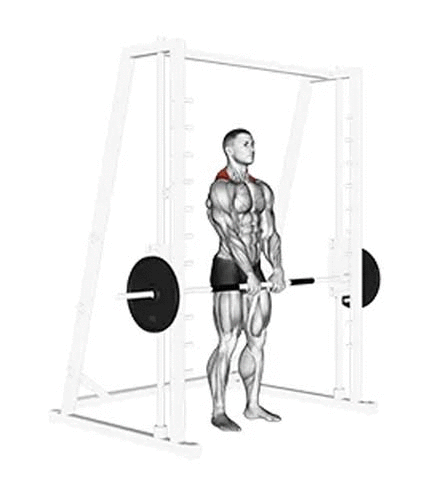
[wp_ad_camp_5]
- Place the bar just below your pelvis.
- Grasp with your palms with a straight grip on top, slightly wider than your shoulders.
Remove the bar from the locks. - As you exhale, raise your shoulders to your head as much as possible, without bending your elbows or bending your body. Make a faster upward movement, pausing for a second at the top point.
- When you breathe in, lower your shoulders and stretch your traps.
Also in Smith Machine, you can perform shrugs with a barbell behind the back. The technique is the same as for the barbell shrugs.
Conclusion
Often, a hypertrophied top of the trapezoid can be found in people with a curved spine. With the weakening of the pectoral muscles, the top of the trapezoid takes responsibility for supporting the spine. Thus, it compensates for the weakness of the pectoral muscles. Of course, the shrug technique should be started after evenly pumped muscles of the chest and back. Then the exercise will visually give a smoother and more aesthetic transition from the cervical spine to the shoulders.





































